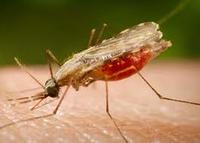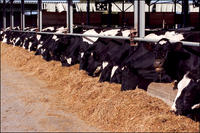-
Entomologists discover new species of malaria-transmitting mosquito

Malaria is the leading cause of death in Kenya, where twenty-five million people out of its population of thirty-four million are at risk; researchers have recently discovered a potentially dangerous new malaria-transmitting mosquito; the as-yet-unnamed, and previously unreported, mosquito breeds in the western areas of Kenya and has an unknown DNA match to any of the existing malaria-transmitting species
-
-
Genetic sleuthing uncovers deadly new virus in Africa
An isolated outbreak of a deadly disease known as acute hemorrhagic fever, which killed two people and left one gravely ill in the Democratic Republic of Congo in the summer of 2009, was probably caused by a novel virus scientists have never seen before
-
-
How vulnerable is the U.S. to agro-terror attack?

Since the 9/11 terrorist attacks, the United States has spent billions of dollars to make the country safer from another catastrophic event, but little of that money, and little attention, have been directed toward preventing, coping with, and recovering from a terrorist agro-attack; how vulnerable is the United States to an attack on its food system?
-
-
Concerns about next month’s Hajj grow as Saudi Arabia identified as source of Sars-like outbreak
The U.K. Health Protection Agency and World Health Organization are attempting to identify a new Sars-like virus which has infected two people so far, one who has died and another who is receiving intensive care; the source of the virus appears to be in Saudi Arabia, which raises concerned that the Hajj pilgrimage next month could provide the virus a chance to spread around the world; thousands of Muslims from all over the world attend the event every year
-
-
Removing toxins from the environment

A Florida State University chemist’s work could lead to big improvements in our ability to detect and eliminate specific toxic substances in our environment; the novel approach is based on stripping electrons from the toxic chemical known as fluoride; in addition to toxin removal, the approach has many other applications
-
-
U.S. models underestimates costs of carbon pollution
Model used by government all but ignores economic damages that climate change will inflict on future generations; two economists argue that when these costs are factored in, the real benefits of carbon reduction range from 2.6 to more than 12 times higher than the government’s estimate
-
-
Precision agriculture using military technology: drones
Drones are military aircraft currently being repurposed for everyday use, especially within the growing field of precision agriculture; these flying robots allow farmers to detect changes in water content, plant health, and pesticide dispersal in their fields
-
-
Tasered youth fare as well as adults: study

Adolescents who are tasered by law enforcement officers do not appear to be at higher risk for serious injury than adults, according to new a new study; the conclusions are based on a retrospective study of Taser use from law enforcement data collected by the largest, independent multicenter database established in 2005
-
-
U.S. urgently needs better bioterrorism, disease tracking system
Nearly eleven years have passed since the fall 2001 bioterrorism-related anthrax attacks that shook the United States, killing five people and injuring seventeen, a leading bioterrorism expert says the country has still not learned its lesson; he says that current data mining approaches are passive and do not provide immediate solutions to the emergencies at hand, proposing instead an electronic, clinician-based reporting system which would have the capacity to limit the impact of a bioterrorism attack
-
-
U.S. schools not ready for next pandemic
Many U.S. schools are not prepared for bioterrorism attacks, outbreaks of emerging infectious diseases, or pandemics, despite the recent 2009 H1N1 influenza pandemic which resulted in more than 18,000 deaths worldwide
-
-
Regional, global food security effects of climate change to felt soon
Research shows that within the next ten years large parts of Asia can expect increased risk of more severe droughts, which will impact regional and possibly even global food security; on average, across Asia, droughts lasting longer than three months will be more than twice as severe in terms of their soil moisture deficit compared to the 1990-2005 period; China, Pakistan, and Turkey as the most seriously affected major producers of wheat and maize
-
-
Rinderpest: how the world’s deadliest cattle plague was eradicated
Rinderpest, the deadliest of cattle diseases, was declared vanquished in May 2011; after smallpox, it is only the second disease (and first livestock disease) ever to be eradicated from the earth; the insights gained from the eradication campaign may be applied to similar diseases that today ravage the livestock populations on which the livelihoods of one billion of the world’s poor depend; the lessons could also be applied to “zoonotic” diseases which are responsible for 2.4 billion cases of human illness and 2.2 million deaths per year
-
-
New synthesis devised for most useful, yet expensive, antimalarial drug
In 2010 malaria caused an estimated 665,000 deaths, mostly among African children; now, chemists have developed a new synthesis for the world’s most useful antimalarial drug, artemisinin, giving hope that fully synthetic artemisinin may help reduce the cost of the live-saving drug in the future
-
-
Questions raised about cost, reliability of BioWatch upgrade

One year ago, DHS said a new contract for Biowatch, a system for detecting biological attacks on the United States, would be awarded in May 2012 and would cost an estimated $3.1 billion during its initial five years of operation; now DHS has decided to postpone the plans due to concerns about cost and reliability
-
-
Government considering options for post-biolab Plum Island

The Plum Island biolab, located on an 840-acre island of the tip of Long Island, has always been shrouded in mystery owing to the sensitive nature of the biological research done in its high-security facilities; now the center is being shut down by DHS, and the government is considering several options regarding what should be done on the island and the research facility
-
More headlines
The long view
Ransomware Attacks: Death Threats, Endangered Patients and Millions of Dollars in Damages
A ransomware attack on Change Healthcare, a company that processes 15 billion health care transactions annually and deals with 1 in 3 patient records in the United States, is continuing to cause massive disruptions nearly three weeks later. The incident, which started on February 21, has been called the “most significant cyberattack on the U.S. health care system” by the American Hospital Association. It is just the latest example of an increasing trend.
